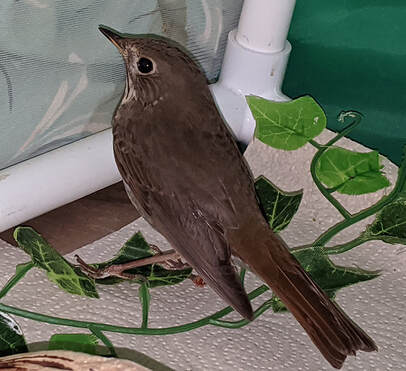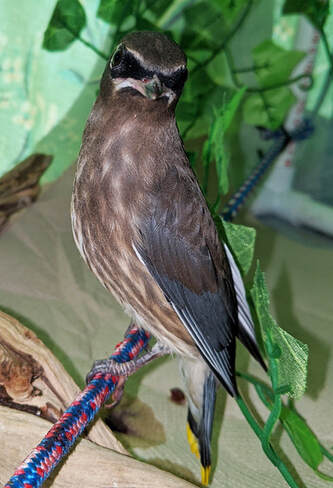 Well here we are moving into the colder, darker months after coming through such an intense year. We thought we'd share a few happy stories of some of our extraordinary patients that wound up needing help. It was the busiest year Native Bird Care has seen. My first baby songbird came in April 1st, two months earlier than any other season in my 11 years. By mid-May I was already ordering 35,000 insects a week; July is usually when our insect demand is that high. All those babies were for the most part singletons, individuals rather than full nests. In fact, I rarely get a full nest, it is mostly single babies who have wound up alone, injured, and needing help. So, like all baby seasons, I worked a 96 hour work week, it just started way early and did not stop for nearly 5 months. And this year, due to Covid, we could not have volunteers. This fall, it has slowed quite a bit but I still have a steady stream of patients needing care. I hate to play favorites since frankly every one of these birds is an amazing, brilliant gem. I love every one of them, even the most irascible, stressy grouch. In fact, it is pure maternal instinct that powers my ability to get up at 6 am every morning to start putting food into mouths and cleaning up poopy enclosures. The bright spot in avian rescue is the babies, little souls with a desperate eagerness to be a graceful, elegant star, traversing the air or cruising the earth. Here are a few of the stars we had this last year. Enjoy them, fawn over their beauty, relish them as if they are the last one of their species. As we lose bird populations, it is so important to value and cherish every single one of them.  Few birds can match the mesmerizing calls of the Hermit Thrush. The sound from this small 25 gram bird erupts as ethereal waves, flowing from the forest edges. Is that one? Two? The call has a ventriloquist aspect, confusing the human listener, making us wander hopelessly in search of the source of that siren song. To no avail. We've had several Hermits this fall, two were simply too weak to fly, another hit a window, which is quite odd as these are migrants that do not seek bird feeders. Starvation is a real issue birds must face, particularly in this day and age. Finding insects is tough work, requiring a never ending hunt for food most of the day. In care here, we get them past the critical care stage that results from emaciation and then load them up on as many insects as they can gobble down. All our Hermit Thrushes were able to be released amazingly, even the window harmed one.  Cedar Waxwings are one of my favorite babies to raise. This one dropped out of a tree onto someone's patio. We tried for 3 days to find the parents and the nest with no luck. I concluded that this one was a runt, and just was not able to hang on in the nest. She had mites as well and was skinny. She ate like a champ though, enjoying fresh berries and insects. Waxwings, like most baby songbirds, are fed small larvae, caterpillars, and other insects. Mainly soft-bodied bugs that are easy to digest. In care, we avoid mealworms with waxwings and feed mainly crickets and some waxworms. These birds grow up to eat berries however, so we dutifully chop of fresh blue and blackberries, and other fruits. She joined a small flock of other Cedar Waxwings in Camp Polk Meadow.  In July, we had the rare opportunity to help a baby Pied Billed Grebe. All grebe species are 100% waterbirds, meaning that they live full time on the water - eating, swimming, sleeping, and nesting in reeds at lake edges. Sadly, people can easily disturb families like this when they paddle into the vegetated areas at the edges of lakes and rivers. And that's what happened to this little one. Luckily the person found the soaked baby and got her to us for warming, drying, and some food. Over the next week we searched the lake, found a parent, and were able to reunite the one. Her sibling sadly died from the ordeal of being in the water too long. Baby down is not waterproof for long, which is why you see them crawl up on their parents' backs and snuggle in for a ride. Lesson: don't paddle into reeds and marsh.  As happens every year, some crew of Northern Flicker babies find themselves homeless as people remove trees, or exclude them from hole in a house. We renest a lot of these guys over the summer, providing flicker boxes to home owners and moving the babes to the box and out of the home. This works incredibly well, and provides a long-term solution for the home owner looking for a way to keep them outside, not in. Get the ant-eating benefit the Flicker provides, while preventing damage. Win-win! Flickers are a blast to raise. Don't get me wrong, they are a ton of work, but these babies are just so full of attitude and personality. Their tongues and foraging techniques are so very neat. If you go to the videos on the Native Bird Care of Sisters Facebook page, you will see one of our young birds from last year show off her phenomenal tongue eating worms in a tree. We had so many species this year - our fun and common Robins and Goldfinches, Townsend Solitaires, Red Breasted Sapsucker, Black Headed and Evening Grosbeak, House Finches, Red Crossbill, Common Poorwill and Nighthawks, Ash Throated Flycatcher, Hairy Woodpecker, Hummingbirds, Quail, Chickadees, Pine Siskin, Spotted Towhee, and then Spotted Sandpiper, Great Blue Heron, and waterbirds like Lesser Scaup and Canada Geese. And that is not all, here are a few more. I could chat about all of them all day.
I hope you have enjoyed this look at our birds. Please make a donation this holiday season. Without public support we simply could not keep doing what we do to save birds. Our food bill alone is $5000 a year. Medications, medical treatment and supplies, everything that goes into enclosures and housing, utility bills, and so much more costs a lot. We have no paid staff, so 100% of your money goes directly to the birds that make their way here. Please donate!
0 Comments
|
AboutNative Bird Care's is celebrating its 10th anniversary! Our main focus is song, shore, and waterbirds. We offer specialized care and facilities for these extraordinary birds.. Archives
July 2024
Categories
|






 RSS Feed
RSS Feed